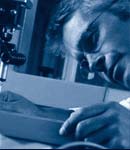|
|
![]() |
![]() |
![]() |
![]() |
![]() |
| Air Pollution and
Mega-cities |
| |
![]() |
Projects
Particulate Air
Pollution in Megacities of the Developing World
(2001)
Optimization of Strategies for Air Pollution
Reduction: Collaborative Field Measurements and Modeling in the
Mexico City Metropolitan Area (2002)
Principal
Investigators
MIT: M. Molina
ETH: H. Siegmann
Air
pollution imposes significant direct and indirect health and
economic costs on society. It overlaps with other complex urban and
environmental issues, such as traffic congestion and mobility, land
use, and global warming, in mega-cities throughout the world. The
Mexico City Metropolitan Area is a prime example of a mega-city in
the developing world facing challenges posed by these
issues.
The AGS has provided support to an on-going research
initiative at MIT, called the Integrated Program on Local, Regional,
and Global Air Pollution, referred to as the Mexico City Case Study.
Goals/Objectives
This research aims to integrate
atmospheric monitoring, health impact evaluation, and modeling of
fine particulates for informed policy analysis. The research is
being carried out as four synergistic activities, with the goal of
improving the capability to assess the effectiveness of proposed
regulation regarding air pollution of fine particles. Specific
objectives include:
- To assess the levels and types of fine particulate matter
affecting population in mega cities of the developing world, using
Mexico City as a case study
- To evaluate the health effects related to the atmospheric
presence of fine particulate matter and develop damage functions
specific to Mexico City
- To estimate the effectiveness of different emission control
measures, using atmospheric modeling
- To design and develop emission control strategies to minimize
population exposure to fine
particles
Results/Findings
A major component
of this research is a field measurement campaign to investigate the
occurrence of elevated photochemical gas and particulate pollutants.
These measurements are to be used in a regional air pollution model
in to provide a firm scientific foundation for regulatory
decision-making to reduce air pollution and human health
impacts.
Field Measurement Campaign
A field campaign in
the Mexico City Metropolitan Area (MCMA) was carried out in February
2002 to collect measurements of various pollutants. The campaign
included measurements of particulate matter (PM10 and PM2.5),
particle-bound polycyclic aromatic hydrocarbons (PAH), and
particulate matter active surface (AS). A mobile laboratory provided
by Aerodyne Research Inc. carried measurement instruments.
Measurements were conducted at several fixed sites in the MCMA, and
were also carried out in the “chase mode,” following buses and
trucks. ETH researchers designed the soot instruments, MIT
researchers conducted the measurements, and Mexican collaborators
provided local support. Some of the key findings to date
include:
- The 24-hour PM10 standard was violated on several occasions.
High emission peaks were observed at night, possibly attributed to
illegal industrial activities.
- The PAH data showed occasional high levels, indicating some
nearby burning activity not detectable by the PM10 or PM2.5
measurements.
- The PAH/AS ratio varied significantly from site to site,
indicating different chemical identities of the fine particles.
- The chase-mode data reveal some interesting trends that are
being analyzed in conjunction with data from the mobile
laboratory.
Additional field campaigns have been
carried out during the first quarter of 2003, and the results are
currently being analyzed.
Commuter Study
Measurements
Measurements during commuting hours were conducted
inside automobiles, buses, minibuses, and the metro along three
typical commuting routes. Some of the key findings include:
- The metro had the lowest concentrations of PAH and AS for all
three routes.
- High PAH/AS ratios were found in various modes, reflecting the
dominance of combustion source particles. The variation of PAH/AS
ratios requires further analysis.
- PAH concentrations are higher inside commuting vehicles than
outdoors.
Research activities for the second through
fourth research objectives are currently underway.
The AGS
research has benefited from integration to the ongoing research
funded by Mexico’s Metropolitan Environmental Commission (CAM) and
the MIT/AGS. The overall project has the infrastructure, personnel,
complementary health effects studies, ancillary atmospheric
measurements, etc., that provide the context to understand and
utilize the results of the AGS research project. One key result from
the overall project is the publication of “Air Quality in the Mexico
Mega City: An Integrated Assessment,” which is for the AGS book
series
The project continues to work closely with Mexican
decision-makers in government in the Federal District, the State of
Mexico and the Federal Government, providing a scientific foundation
to their regulatory activities. For example, a new air quality
program in Mexico City (PROAIRE 2000-2010) has been drafted on the
basis of recommendations made by the project. The AGS research has
also resulted in the initiation of activities to design better
inspection and maintenance programs for diesel trucks, and in the
consideration of programs to retrofit the trucks with particle traps
to reduce the emission of soot.
More Information
Website |
|



